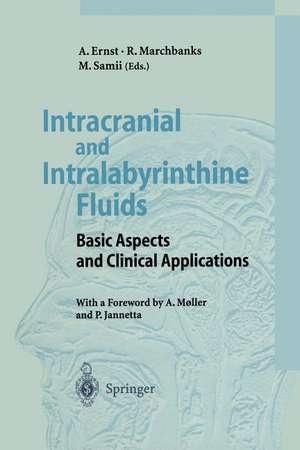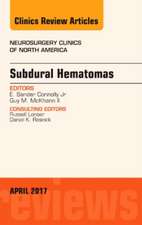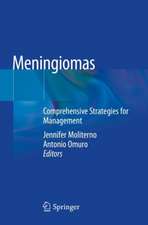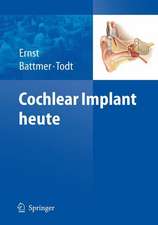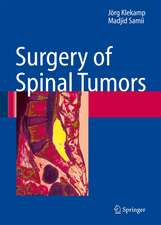Intracranial and Intralabyrinthine Fluids: Basic Aspects and Clinical Applications
Editat de Arne Ernst Cuvânt înainte de A. Moller, P. Jannetta Editat de Robert Marchbanks, Madjid Samiien Limba Engleză Paperback – 13 dec 2011
Preț: 717.00 lei
Preț vechi: 754.74 lei
-5% Nou
Puncte Express: 1076
Preț estimativ în valută:
137.20€ • 146.71$ • 114.39£
137.20€ • 146.71$ • 114.39£
Carte tipărită la comandă
Livrare economică 17 aprilie-01 mai
Preluare comenzi: 021 569.72.76
Specificații
ISBN-13: 9783642801655
ISBN-10: 364280165X
Pagini: 320
Ilustrații: XIV, 300 p.
Dimensiuni: 155 x 235 x 17 mm
Greutate: 0.45 kg
Ediția:Softcover reprint of the original 1st ed. 1996
Editura: Springer Berlin, Heidelberg
Colecția Springer
Locul publicării:Berlin, Heidelberg, Germany
ISBN-10: 364280165X
Pagini: 320
Ilustrații: XIV, 300 p.
Dimensiuni: 155 x 235 x 17 mm
Greutate: 0.45 kg
Ediția:Softcover reprint of the original 1st ed. 1996
Editura: Springer Berlin, Heidelberg
Colecția Springer
Locul publicării:Berlin, Heidelberg, Germany
Public țintă
ResearchDescriere
There is no question that the topic of this meeting in Seeheim, Germany, on intracranial and intralabyrinthine fluids is pertinent. This was the first international meeting at which these two closely-related topics were addressed together. Combining the clinical and research aspects of fluid and pressure regulation in the intracranial and the intralabyrint hine compartments as well as discussions on the clinical implications of abnormal fluid pressure was an excellent idea. The presentations and discussions of both the clinicians and basic scientists who participated proved that the concept of having such a combined focused gathering was both original and relevant. The two topics of the meeting in Seeheim have much in common. Maintaining both the intracranial pressure (lCP) and the intralabyrinthine pressure within normal limits is important for the normal functions of both the central nervous system and the ear. The intracranial space and the intralabyrinthine space are closed compartments that communicate with each other in an intricate manner. Deviations from normal intracranial pressure result in specific symptoms and signs. Medical problems related to elevated intracranial pressure vary from subtle to severe. Accumulated knowledge indicates that there are adverse effects from even relatively small elevations in ICP. Elevations in ICP may cause injuries to the brain and the ear. Abnormal pressure in the ear may cause abnormal function and injury. Maintaining the intracranial pressure within normal limits depends on a normally functioning pressure regulation.
Cuprins
1. Basic aspects of intracranial and intralabyrinthine fluids.- Stretch-activated channels and volume regulation in Opossum kidney cells.- Extracellular space ionic composition, volume and geometry during neuronal activity and pathological states.- Longitudinal fluid movements in the cochlea under normal and abnormal conditions.- The effect of volume regulatory mechanisms in auditory sensory cells to compensate for volume and pressure overload.- Ionic control of volume and pressure regulation in the labyrinth.- 1.1. Structural and functional aspects of the intracranial and intralabyrinthine fluid-filled compartments.- Communication routes between intracranial and intralabyrinthine fluid-filled spaces.- Hydromechanical interactions of the intracranial and intralabyrinthine fluids.- Pressure relation between the labyrinthine and intracranial fluids.- Correlation of direct and non-invasive ICP measurements in cat.- Experimental endolymphatic hydrops and inner ear pressure.- Intralabyrinthine pressure transmission of intracranial pressure in the normal guinea pig.- Hydrocephalus and the status of endolymphatic membranes in temporal bones of children.- Composition, formation and flow of intralabyrinthine fluids.- Differences in biochemical composition between perilymph, cerebrospinal fluid and blood plasma in the guinea pig.- Connections between the cerebrospinal fluid space and the lymphatic system of the head and neck in humans.- Magnetic resonance imaging of the intralabyrinthine fluids under physiological and pathological conditions.- High-resolution magnetic resonance imaging of the fine structure of the human cochlea.- Clinical significance of the large vestibular aquaeduct.- 2. Clinical applications.- 2.1. Diagnostic tools in monitoring and imaging.- Electrophysiological monitoring in neurosurgical patients with increased intracranial pressure.- Otoacoustic emissions: a new tool for monitoring intracranial pressure.- The effect of body position on transient otoacoustic emission.- Non-invasive perilymphatic pressure measurement in normal hearing subjects and in patients with Meniere’s disease using the MMS-10 Tympanic Displacement Analyser.- Age-related changes in perilymphatic pressure: Preliminary results.- Diagnostics of perilymphatic hypertension.- The prevalence of perilymphatic hypertension in tinnitus patients.- Assessment of the clinical value of the Tympanic Membrane Displacement (TMD) test in children with shunted hydrocephalus.- Neuro-otological findings in raised intracranial pressure.- Papilledema in cases of acute elevated intracranial pressure.- Optic nerve changes in raised intracranial pressure.- Fluctuating hearing loss in patients with large vestibular aqueduct syndrome.- Audiologic characteristics of patients with the X-linked stapes gusher syndrome.- TMD recordings in patients with intracochlear hyper- and hypotension.- Round Window Displacement caused by altered middle ear pressure inducing impairment of bone-conduction threshold?.- 2.2. Medical and surgical management of elevated intracranial and intralabyrinthine pressure.- Pseudotumor Cerebri: Symptoms, associations, etiological considerations and therapy.- Otolith disease — experimental findings and clinical implications.- The X-recessive progressive, mixed deafness syndrome with perilymphatic gusher during stapes surgery (DFN 3).- Surgical management of stapes gusher in middle ear surgery.- Recurrent perilymphatic fistula as the initial and prime symptom of pseudotumor cerebri: Diagnosis and management with lumbarperitoneal shunt — Report of three cases.- 2.3. Round table discussion: “Surgical management of intracranial and intralabyrinthine hypertension“.
Textul de pe ultima copertă
This book provides an overview of current scientific knowledge on volume and pressure regulation as well as on basic neuroscientic aspects of liquor and labyrinthine space. Clinical and surgical concerns regarding diagnostics -such as non invasive pressure measurements methods- and therapy -such as neuroendoscopy and neuronavigation- are discussed.
